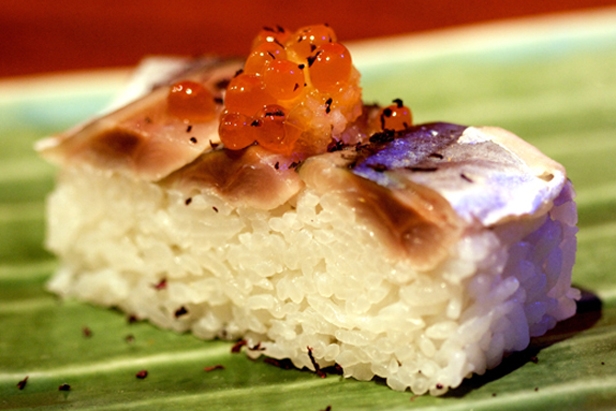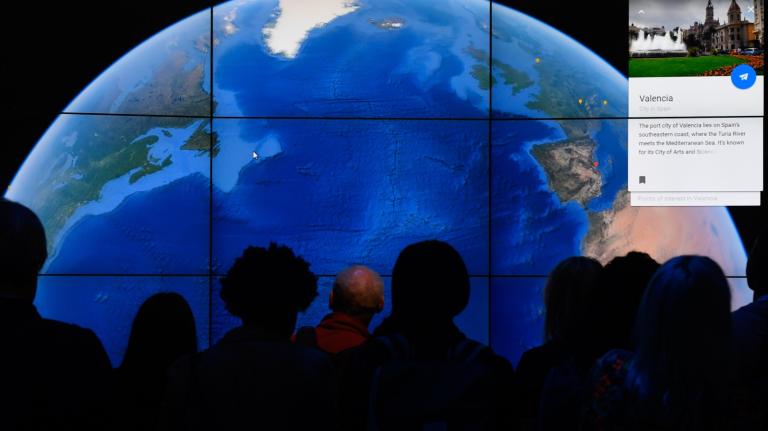 Scallop and dungeness crab salad wrapped in prosciutto topped with lumpfish caviar and avocado: A Hajime creation. Photo by Phu Son Nguyen of sushiday.comGrowing up in small-town Montana, two things just made no sense: vegetarians and sushi. Why eat tofu, or raw fish, when you could just as easily have a big juicy steak? Coming from generations of cattle rancher stock, I read Jonathan Safran Foer’s ringing defense of vegetarianism, Eating Animals, with trepidation. But the only beef I ended up having with Foer was that he ruined my ability to enjoy the raw and the rolled — right after I had moved to sushi paradise, Seattle.
Scallop and dungeness crab salad wrapped in prosciutto topped with lumpfish caviar and avocado: A Hajime creation. Photo by Phu Son Nguyen of sushiday.comGrowing up in small-town Montana, two things just made no sense: vegetarians and sushi. Why eat tofu, or raw fish, when you could just as easily have a big juicy steak? Coming from generations of cattle rancher stock, I read Jonathan Safran Foer’s ringing defense of vegetarianism, Eating Animals, with trepidation. But the only beef I ended up having with Foer was that he ruined my ability to enjoy the raw and the rolled — right after I had moved to sushi paradise, Seattle.
“Imagine being served a plate of sushi. But this plate also holds all of the animals that were killed for your serving of sushi. The plate might have to be five feet across,” Foer writes. At current rates of fishery depletion, scientists predict the demise of most seafood by 2048.
Foer describes modern fishing as warfare. Hajime Sato has a similar take: “[It’s] like someone is beating somebody and I’m just walking by and noticing it but not doing anything about it.”
But Sato isn’t an environmentalist author or even a vegetarian. He’s chef and owner of Mashiko, a Seattle sushi restaurant. Not wanting to throw punches himself anymore, he revised his menu to include only sustainable fish last August.
Sato, who not only serves sushi but teaches others how to prepare it, knew the dreadful truth about certain fish. For a time, however, he served them anyway. But then he met Casson Trenor, author of Sustainable Sushi.
Trenor knows just about everything that’s wrong or right about what can end up between your chopsticks. For instance, the most disgusting thing about shrimp isn’t even their visible poop veins: “Some shrimpers have been known to discard more than ten pounds of unwanted sea life for every pound of shrimp they keep,” he writes.
After talking to Trenor about sustainability, Sato said, “Okay, within three months, I’ll change it [the menu] entirely.” Trenor didn’t believe Sato. But, Sato recalls, “I said ‘No, when I say I’ll do something, I’ll do it. That’s me.'” And he did.
 Not your typical sushi chef. Not your typical sushi. Photo by Phu Son Nguyen of sushiday.com“Don’t do anything mediocre,” he says. Not a surprising personal motto from someone who races motorcycles and whose diners are greeted by a sign that reads “Please wait to be seated. Unless you’re illiterate.”
Not your typical sushi chef. Not your typical sushi. Photo by Phu Son Nguyen of sushiday.com“Don’t do anything mediocre,” he says. Not a surprising personal motto from someone who races motorcycles and whose diners are greeted by a sign that reads “Please wait to be seated. Unless you’re illiterate.”
Sato took a big risk with his 15-year-old, award-winning restaurant.
The first few months were rocky; Sato couldn’t sleep for worrying. “Should I go back? Am I doing the right thing?” he asked himself, “People don’t get it.”
But business rebounded and he continues to be resolute about sustainability. He finds careless pescatarians’ logic odd and is incredulous that there are international laws against eating cheetahs, but Bluefin tuna have only very limited protection. “You can basically wipe the entire species out in a week and say okay, next …”
Although the plight of the Bluefin tuna has made headlines recently, Sato points out that eel (unagi) is the worst fish to serve. “Eel is actually [at] the category of extinction. It’s not even endangered anymore. But people are still eating it,” he says.
 Whatcha doin’ back there? This mysterious lover is a breed of eel that won’t end up on your plate. Its populations also happen to be healthy. Photo courtesy Richard Ling via Flickr The spooky thing about eels, besides their mean mugs, is their mysterious breeding habits. It’s not just that eel lovin’ is an unpleasant subject: “They [eels] go back and forth between fresh water and salt water about four or five times in their life. And we have no idea how they mate, how they reproduce at all. So let’s not really touch the eel.”
Whatcha doin’ back there? This mysterious lover is a breed of eel that won’t end up on your plate. Its populations also happen to be healthy. Photo courtesy Richard Ling via Flickr The spooky thing about eels, besides their mean mugs, is their mysterious breeding habits. It’s not just that eel lovin’ is an unpleasant subject: “They [eels] go back and forth between fresh water and salt water about four or five times in their life. And we have no idea how they mate, how they reproduce at all. So let’s not really touch the eel.”
Wild or farmed, eating unagi is never a good idea. In eel farms, they take the young from the wild and fatten them up. Those eels never even get the chance to do whatever only God knows they do in the dark.
Eel is classified as a red fish in Trenor’s book. Helpfully, he divides fish into three color categories. Green means chow down: “These fish and shellfish are caught or farmed in ways that don’t have any major adverse effect on the environment.” Nimbly nibble yellow fish: “Animals in this category are from fisheries that are either poorly understood or have some troubling characteristics. Limit your consumption of these animals.” And red, of course, means by all means stop: “Fish and shellfish are caught or farmed in a manner that is inordinately deleterious to the health of the oceans.”
Sato mostly serves green fish, but he serves some yellow, too. Occasionally a customer will ask him, “Are you 100 percent okay with this?” “No,” he replies, “I eat the same as any other practice I do. I drive a car.”
But what if every fish out there was classified red tomorrow?
Then I’m not going to serve. I’m going to have a vegetarian restaurant. Which is totally fine. But I’m trying to prevent it. I’m trying to prevent it so we can do this. People tend to wait wait wait until the last moment and then freak out. Let’s freak out just a touch more right now.
Keeping up to date on the status of each fish he serves takes a lot of time. “You cannot just stop learning about it,” he insists.
Trenor and Sato’s relationship continues. Sato reads Japanese publications on sustainability and Trenor reads English sources. They talk three times a week to share what they’ve learned.
Sato, the first traditionally trained sushi chef to go sustainable, can’t understand Japanese aversion to sustainable sushi: “The reality is, if you really read the history of sushi, tuna actually was not in there, [nor] toro, unagi … I’m basically going back to what traditional is. They didn’t have a huge fleet of boats.”
Though he doesn’t intend to challenge veteran sushi chefs (“They’d kill me with a knife”), Sato hopes to promote sustainable sushi and bring more chefs into the fold. He understands the difficulties of switching to and finding sustainable fish, but he’s willing to share his experience and support those who face the same hardships.
 Have you ever even heard of the Sanma fish? Photo by Phu Son Nguyen of sushiday.com“I had to say goodbye to distributors that I’d been using for 15 years, which is really tough. They sometimes helped me out when I was in financial trouble,” he says. He went from having four or five distributors to nearly 20 in order to fill out his menu. He sees this as a plus for his diners, giving them choices far beyond the standard fare. “There’s so many other fish. But some people don’t get that,” he says. Sato recommends diners relax and expand their tastes. “Today eat this, tomorrow eat that. It’s good for the ecosystem, economy, everything.”
Have you ever even heard of the Sanma fish? Photo by Phu Son Nguyen of sushiday.com“I had to say goodbye to distributors that I’d been using for 15 years, which is really tough. They sometimes helped me out when I was in financial trouble,” he says. He went from having four or five distributors to nearly 20 in order to fill out his menu. He sees this as a plus for his diners, giving them choices far beyond the standard fare. “There’s so many other fish. But some people don’t get that,” he says. Sato recommends diners relax and expand their tastes. “Today eat this, tomorrow eat that. It’s good for the ecosystem, economy, everything.”
In the past, his business philosophy was to make sushi affordable for everyone. He’s kept his prices low and his sushi delicious, but his philosophy has changed to something he calls egocentric: “I’d like to keep my business longer than the next five years.”
Ultimately, Sato believes the fate of the fish and our ability to eat them in the future is up to the consumer. He hopes we choose wisely.
If you’re not in the Seattle area, bring Trenor’s book with you to your favorite restaurant, the grocery store, the fish market. Ask questions.
The Monterey Bay Aquarium has a good, simple pocket guide as well. And you can see how your local seafood restaurants measure up at Fish2Fork. Finally, check out Mashiko’s website sushiwhore.com, where you can read Sato’s blog about sustainability, peruse his mouth-watering menu, and watch silly sushi videos. (And it’s pointed out that sake is sustainable.)



